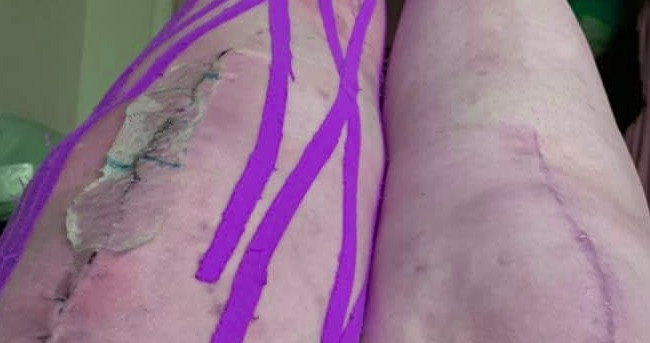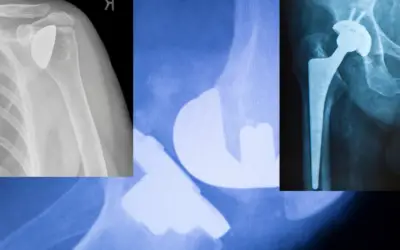Does RockTape Kinesiology Tape Help Recovery After Total Knee Replacement
Yes, kinesiology tape has been studied and may be effective for patients following total knee replacement surgery.
Here is a quote from a recent study concluding:
“KT technique appeared to be beneficial for reducing postoperative pain, edema, improving knee extension in early postoperative rehabilitation period.” [1]
Where can I buy RockTape?
There are several places to buy what RockTape.
The most common place is on Amazon.com. You can also go to the RockTape.com website for pricing.
If you are currently in physical therapy your physical therapy provider might be able to sell you RockTape buy the Box.
What is the difference between RockTape and Kinesiology tape?
RockTape is a kind of kinesiology tape.
Kinesiology tape is the name for the product category, while RockTape is the name of the specific brand.
The manufacturer of RockTape has specifically designed this product for athletes.

How do I apply kinesiology tape to my knee after knee replacement surgery?
Click to watch the video below to see how this therapist is applying kinesiology tape to a patient following a total knee replacement.
How long should I leave kinesiotape on my knee?
It is generally safe to leave kinesiology tape on your skin for between 48 and 72 hours.
If you find that the tape continues to stick be on 72 hours it is recommended that you remove the tape and allowed the skin to last for 24 hours before applying a new set of tape .
Is there a kinesiology tape specifically for sensitive skin?
Yes, below is a link to HARUTO Sports Kinesiology Tape Sensitive Pre-Cut. This tape is specifically designed for individuals with sensitive skin.
Is it safe to shower with kinesiotape?
Kinesiology tape is designed to be water resistant and should remain on your skin during a shower.
If you remain submerged under water or either in a pool or in a bathtub it’s recommended to remove the tape and reapply.
Why won’t kinesiotape stick to my skin?
The main reason why kinesiology tape doesn’t stick to someone’s skin is usually due to the oil secretions from the skin. There are skin cleaners that may be used prior to applying to tape to improve adhesion.
Below is a list of three options to apply to your skin before using kinesiology tape.
Should I shave before applying kinesiotape?
Yes, it is recommended that you shave the body part before applying kinesiotape to improve it he’s in. If you have light body hair you may be able to apply the tape without shaving.
My personal opinion of kinesiology tape in general:
Click on the video below to hear my opinion as a licensed physical therapist.
Reference:
1. Donec V, Kriščiūnas A. The effectiveness of Kinesio Taping® after total knee replacement in early postoperative rehabilitation period. A randomized controlled trial. Eur J Phys Rehabil Med. 2014 Aug;50(4):363-71. Epub 2014 May 13. PMID: 24819349.

Anthony Maritato, PT
Physical Therapist
Anthony Maritato, PT is an Ohio licensed physical therapist and private practice owner.
Mr. Maritato specializes in helping patients who have received a total knee replacement or rotator cuff repair surgery. Ohio license #PT011602
Related articles:
Disadvantages of Knee Replacement Surgery
Table of Contents Introduction Pain Time Lost Cost Stress Post Surgical Risk or Complications Conclusion Introduction When considering treatment options for severe knee arthritis, one commonly considered intervention is knee replacement surgery. Despite its high...
Worst Day After Knee Replacement
What is the worst day after knee replacement? I am a physical therapist who specializes in treating patients after a total knee replacement. In my experience, the worst day after knee replacement is the third day. I will explain why in this article and share some...
What is the most painful joint replacement surgery in 2023
Introduction to Joint Replacement Surgeries Joint replacement surgery is a common and highly effective treatment option for severe pain and functional limitations associated with a variety of joint disorders. This surgical procedure involves replacing a damaged joint...




